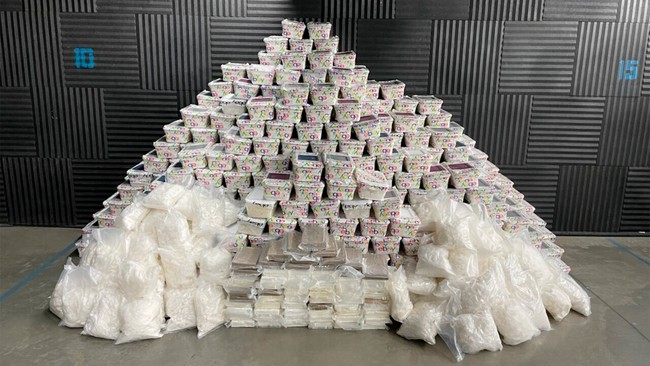
Once the U.S. began taking border security more seriously, the cartels simply changed direction, literally. They went around it.
The Pacific Ocean and the Gulf of Mexico, vast and largely unguarded expanses of open water, have become the new superhighways of the Mexican drug trade. No more tunnels. No more coyotes bribing border agents.
Now, it’s go-fast boats, narco-submarines, and innocent-looking fishing vessels quietly hauling tons of cocaine, fentanyl, and meth toward the United States.
This isn’t an evolution. It’s a strategic pivot. And unless our leaders recognize the scale of the shift and fund the right tools to counter it, the so-called drug war is going to start resembling the war in Afghanistan: long, bloody, and largely one-sided.
When the Land Border Closes, the Sea Opens
For years, America’s border crisis was a terrestrial issue. Migrants, smugglers, and traffickers tried to overwhelm entry points from San Diego to the Rio Grande Valley. Walls were built. Troops were stationed. Legal and political battles ensued.
But the cartels, unlike the bureaucracies they exploit, are nimble and adjust quickly. Once land smuggling faced tighter scrutiny, they began using the ocean as a workaround.
And they’ve become good at it.
According to the U.S. Coast Guard, cartels are deploying high-speed “go-fast” boats loaded with drugs that can evade traditional patrol vessels.
These boats skim just above the waves at 50 knots, are often painted dark blue or black to blend with the water, and have spotters aboard with radios, ready to dump cargo or divert course at the first sign of law enforcement.
Worse still are the narco-submarines: low-slung, semi-submersible vessels made of fiberglass and nearly invisible to radar. Capable of carrying five to ten tons of narcotics at a time, they’re rarely spotted, and even less frequently caught.
And then there’s the deception play. Fishing trawlers that look ordinary on the surface often carry secret compartments, falsified logs, and corrupt captains who’ve sold their souls to the Sinaloa or Jalisco cartels. The drugs are wrapped in plastic and packed beneath genuine fish catches. To the untrained eye, it’s a legal commercial vessel.
What the U.S. is Doing to Fight Back
It would be wrong to say we’ve done nothing. The Coast Guard and Navy have been increasingly active in this maritime drug fight, although they’re stretched thin across massive patrol areas.
In March 2025, U.S. Coast Guard operations netted over 80,000 pounds of illegal narcotics in joint missions across the Pacific and Caribbean. That’s impressive. But it’s estimated that four get through undetected for every vessel seized.
The Coast Guard relies heavily on an airborne force to combat the speed advantage of go-fast boats. Enter HITRON, the Helicopter Interdiction Tactical Squadron.
These crews, armed with .50-caliber sniper rifles and stationed aboard Blackhawks or MH-65 Dolphins, can track suspect vessels from the sky and disable their engines with precision shots. They aim for the outboards: one bullet, one stall. Then, the boarding teams arrive.
This aggressive tactic has proven effective. Coast Guard data shows interdictions succeed nearly 90 percent of the time when AUF is deployed. But it’s resource-intensive, and there are not enough helicopters or trained marksmen to cover every suspicious movement on the water.
The U.S. Navy has also stepped up support. Frigates and destroyers have begun patrolling known smuggling corridors, often providing radar and satellite intel to smaller Coast Guard cutters. Both ship- and land-launched drones are increasingly critical for real-time surveillance.
Still, ocean surveillance is like playing Whac-A-Mole on a blue football field the size of half the planet.
Legal Barriers and Jurisdictional Confusion
The legal process is murky even when the Coast Guard spots and stops a smuggler. Most of these seizures happen in international waters, meaning prosecutions depend on the vessel’s flag, the captain’s nationality, and bilateral agreements with the country of origin.
Some drug boats scuttle themselves, leaving no evidence behind. Others claim distress or claim to be legitimate operations until evidence proves otherwise.
All of this burns time and resources. And in the meantime, the cartels adapt again. They’ll switch routes, hire new crews, or fake distress signals to buy themselves time. If you think these organizations aren’t watching how we enforce our own laws, think again.
Fentanyl’s Ocean Highway
While cocaine remains the most significant volume of cargo moving by sea, fentanyl is the more terrifying threat. Cartels don’t need to ship tons of fentanyl. Just kilograms. A backpack full of it is enough to poison an entire city. And it’s often smuggled in tiny, undetectable quantities, hidden inside legitimate shipping containers, or in the fuel tanks of cartel-controlled vessels.
In 2024, Chinese precursor chemicals used to manufacture fentanyl were discovered aboard a seized fishing vessel off Baja California. That ship was flagged under Honduras, crewed by Guatemalans, and chartered by a shell company registered in Belize. Untangling that web is part of the challenge.
It’s not just about drugs anymore. It’s a game of chess. Every move the U.S. makes is met with two countermeasures from the cartels. And they play to win.
What Needs to Happen Now
First, Congress must fully fund maritime drug interdiction. That includes more HITRON teams, more forward-deployed cutters, and increased collaboration between Coast Guard and Navy assets.
Second, drone and satellite technology must be streamlined and shared across agencies. The Coast Guard, DEA, Navy, and Border Patrol all have access to different tools. Until those tools talk to each other in real time, we’ll continue missing opportunities to strike.
Third, we must pressure our southern partners, Mexico, Guatemala, and Colombia, to permit faster joint operations. Right now, red tape keeps U.S. teams waiting for authorization, even when cartel vessels are clearly violating international law.
And finally, we need public awareness. The American people must understand that the drug crisis is no longer just about overdoses in urban alleys or addiction in rural homes. It’s about national security. These are paramilitary operations disguised as smuggling runs. The people funding them are not just drug lords; they are warlords.
The Clock Is Ticking
Every time we seize a vessel, the cartels learn. Every loophole they find is monetized and multiplied. This is not a war we can win with half-measures or political slogans. It will take aggressive enforcement, international diplomacy, and an iron stomach for confrontation on the high seas.
It’s a new front in the oldest war. And we are already behind.











